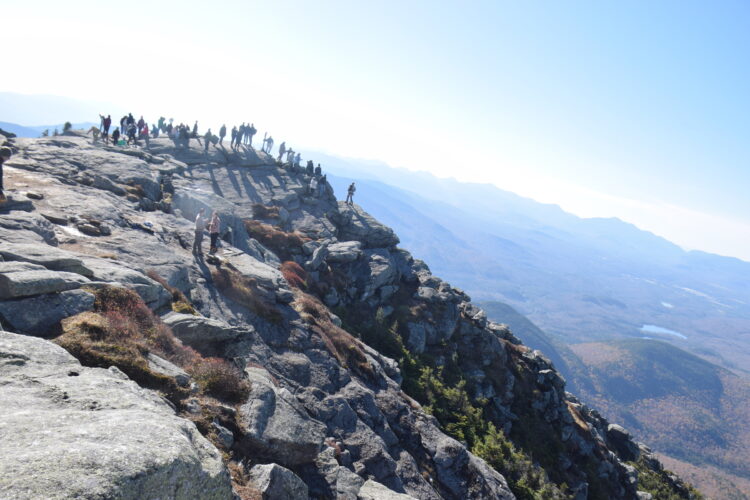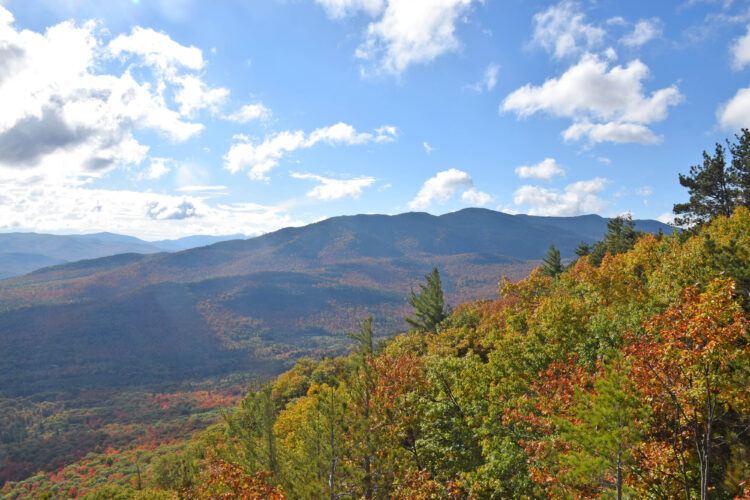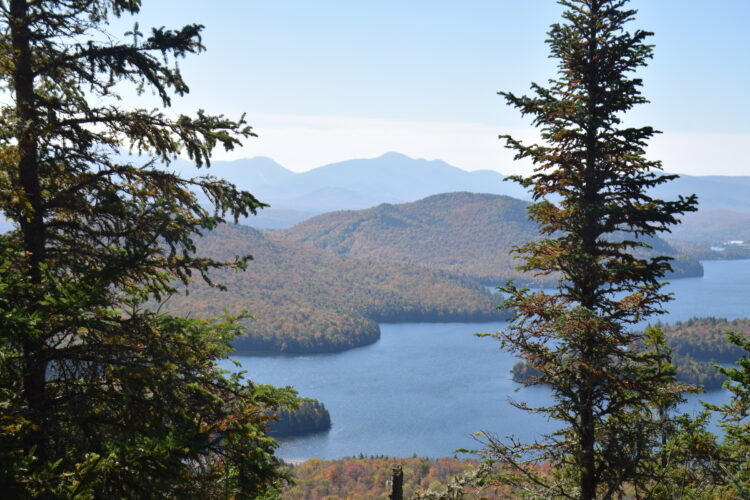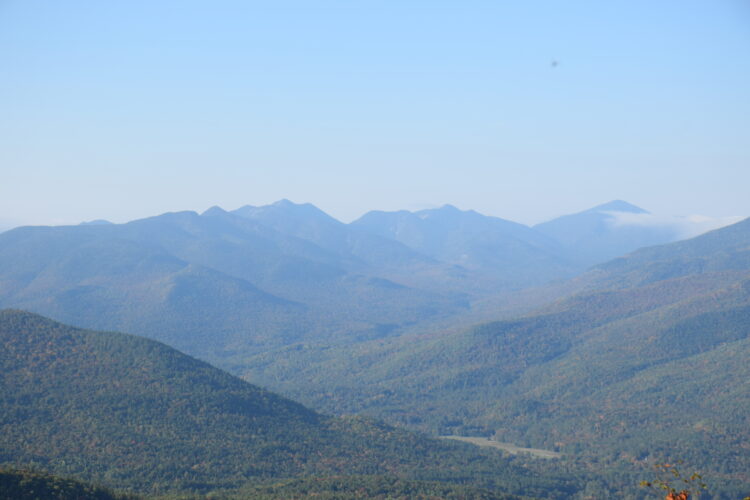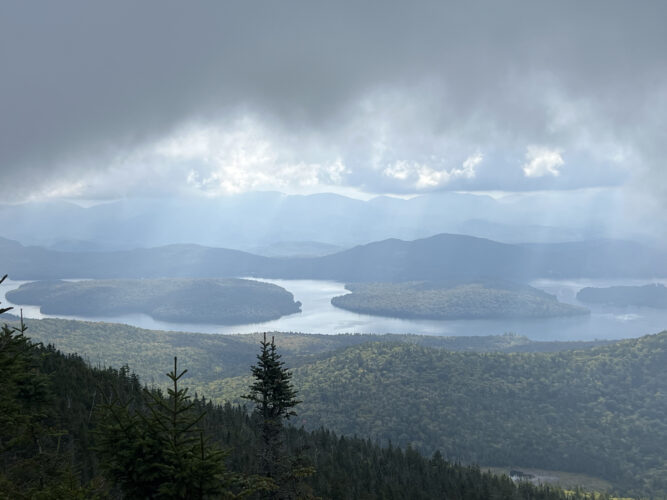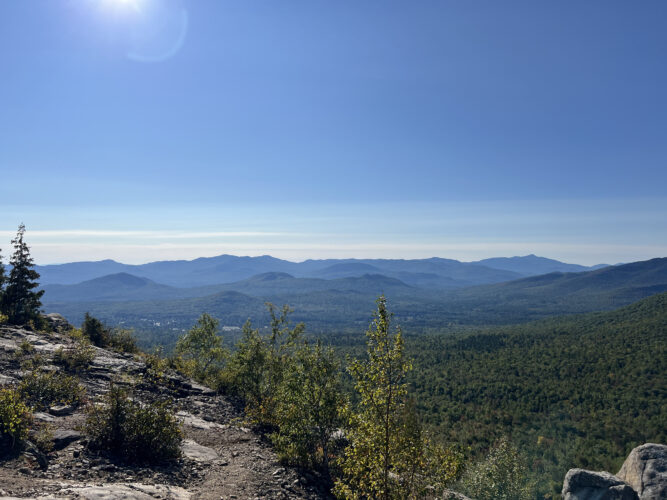Rising to the challenge: Finding a summit at dawn at Cascade Mountain
- Packed snow and ice created a trail “monorail” in places above 3,500 feet en route to Cascade’s summit on Tuesday, April 29.
- News photos — Chris Gaige The sun rises over Vermont’s Green Mountains as seen from the summit of Cascade Mountain on Tuesday, April 27. Numerous other High Peaks can be seen, mostly right of the sun.
- Battery-powered light made the ascent possible.
- Gabrielle Lariviere and Mikael Carreiro watch the sunrise atop Cascade Mountain on Tuesday, April 29. The two were visiting the Adirondacks from Quebec.
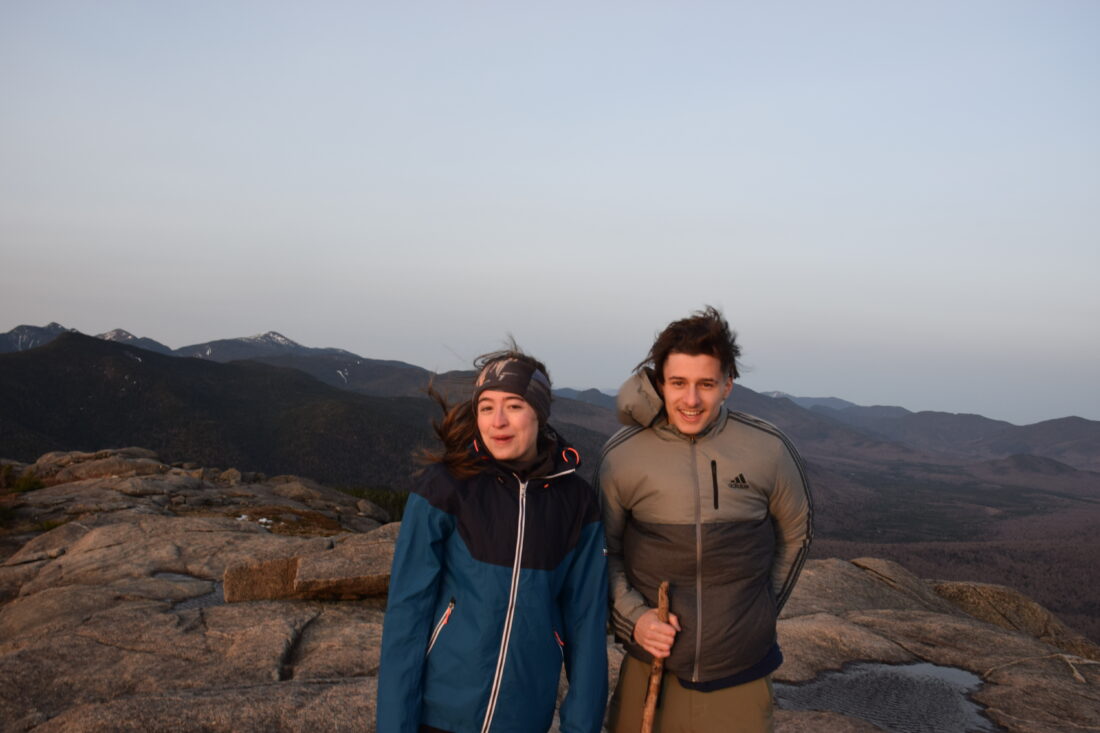
Gabrielle Lariviere and Mikael Carreiro watch the sunrise atop Cascade Mountain on Tuesday, April 29. The two were visiting the Adirondacks from Quebec.
LAKE PLACID — The toughest part came right at the beginning — well before I summited in screaming gale-force winds, slogged through deep mud, ice and snow or even laced up my boots.
My alarm clock rang out at 3:30 a.m. sharp on Tuesday, April 29 — two and a half hours ahead of my typical rise and shine time. I mustered all of the fortitude I had in the moment, just enough to roll over to turn it off. My momentum stopped, and I laid in bed. My eyes were heavy and my body was weary.
I drifted in and out of consciousness for what felt like an hour, but it was only three minutes, per my alarm clock. In that time, I waffled and wavered on my plans. I was ready to throw in the towel and get my full eight hours of slumber.
Fortunately, before rationality prevailed, I sprang up and threw on my gear. It was go time, and there was no turning back.
The story begins two days earlier on Sunday, April 27. I was planning out my Visiting Lake Placid adventure of the week. It occurred to me that I had completed many local hiking trails in my time with the News, and many more before then. However, those had all been completed in broad daylight for the most part.
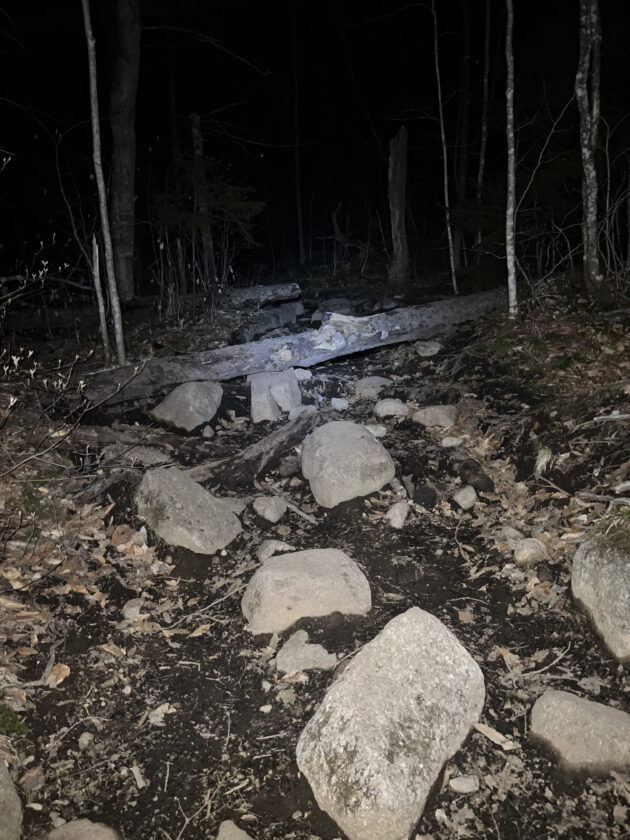
Battery-powered light made the ascent possible.
In all of my adventures, I had never caught a High Peaks sunrise from a mountain itself. Sure, there were early starts and late finishes on longer treks that took place as the sun rose or set, but I was well beneath the tree line on those occasions, and missed them. I had heard spectacular tales and seen phenomenal photos — knowing that as remarkable as these were, it was nothing like being there in the moment and watching it first-hand.
Luckily, the weather forecast, as fickle as it can be for the Adirondacks, appeared conducive for a sunrise viewing on Tuesday, April 29. The next planning phase commenced and I began scouting out possible destinations. I was in the market for a trail that provided relatively short mileage — to cut down on the pre-dawn ascent time — and offered unimpeded summit views, especially to the east.
Since I would be completing half of the hike by light of a headlamp, and aware that spring can present especially tricky and variable trail conditions, I also wanted a trail that I was familiar with and had hiked before, the more times the merrier.
I poured over my shortlist on Monday, April 26, and a frontrunner soon emerged: Cascade Mountain. As I settled on the destination, I packed for the trip the night before to cut down on the amount of time spent on logistics the morning of the hike, when I knew I would be groggier and far more likely to forget something important. I organized water, warm clothing, microspikes, not one but two headlamps and battery sets and, of course, my camera to capture the journey.
I meticulously organized the items in my backpack and made a mental note of where each was for efficient access once I hit the trails. I stashed my hiking clothes, boots and trekking poles next to my pack in order. The idea was to get out the next morning in an assembly line fashion — all of my trip “materials” at the ready, allowing for peak efficiency.

News photos — Chris Gaige The sun rises over Vermont's Green Mountains as seen from the summit of Cascade Mountain on Tuesday, April 27. Numerous other High Peaks can be seen, mostly right of the sun.
Timing is always important when it comes to hiking in the High Peaks. It, however, takes on an especially key role when planning a sunrise hike, as everything centers around being at the intended location by a precise moment.
The sunrise for Lake Placid that day was 5:49 a.m. Knowing that I would (provided everything went according to plan) be at 4,098 feet and have a longer line of sight to the east, I built in a few extra minutes and figured I needed to be at the summit at 5:45 a.m.
I worked backwards from there, calculating how long it would take me to ascend the approximately 2.2-mile trail that gains about 1,900 vertical feet from the trailhead to the summit. I gave myself plenty of extra time. The last thing I wanted to do was create a situation where I would be inclined to rush my pace in the dark to catch the sunrise.
On top of planning to be moving at a personally slower pace, I built in more time yet in case I had to change a battery or throw on my microspikes as I encountered snow higher up. I consulted social media trail reports from recent Cascade trips, most of which mentioned some snow and ice on the route above 3,200 feet. Finally, I built in the commute time and gave myself a few extra minutes in case I was slow to rise from bed, as ultimately ended up being the case.
I calculated that I should start my hike by 4:15 a.m. — something I triple-checked before setting my alarm the night before.

Packed snow and ice created a trail "monorail" in places above 3,500 feet en route to Cascade's summit on Tuesday, April 29.
The hike
As most locals or longtime visitors know, Cascade is one of the most popular, if not the most popular, hikes in the area. Standing at 4,098 feet, Cascade is the 36th tallest of the 46 High Peaks and the 37th tallest mountain in the state.
Its popularity stems from its relatively short — compared to other High Peaks — 4.5-mile total distance and its bald summit, which provides complete 360-degree views. On a clear day, a majority of the High Peaks can be seen from Cascade’s summit.
The heavy usage has taken its toll, whether in the form of dangerous overcrowded parking conditions alongside state Route 73, a trail that has been drastically eroded and widened in many spots or a heavily walked-upon summit where some hikers haphazardly trample fragile alpine vegetation.
All of these factors would make me want to steer clear of Cascade on a busy summer or fall day. I, however, had a sneaking suspicion that I would not be contending with the crowds pulling up to the trailhead at 4 a.m. at the end of April. Spoiler alert: I was correct.
Located on the eastbound side of state Route 73 about 8 miles south of downtown Lake Placid the parking lot was a ghost town. I locked my car, flicked on my headlamp and set off into the woods, right on time. My batteries did not fail, and the path in front of me was marvelously illuminated, allowing me to easily see any rocks, roots or other obstacles that needed to be scaled.
After a brief descent from the highway’s shoulder, the sign-in register appears. From there, the trail begins climbing at a persistent moderate clip. While not very technical compared to other High Peaks, the aforementioned erosion makes for a craggily trail with an abundance of trip hazards.
Given that the day before had warmed well into the 60s and temperatures that night hadn’t fallen below freezing, the trail was extremely muddy. At about 0.3 miles from the parking lot, the trail crosses a small stream. While I was able to rock hop without incident, the crossing requires some agility, especially during higher flows.
The trail continues at a steady incline until about 0.9 miles, when it levels off for about a tenth of a mile, offering hikers a brief reprieve. There are a couple of other short flat stretches, but the climb was steady for the most part.
At around 1.5 miles, or 3,450 feet in elevation according to my GPS-tethered watch, ice and snow conditions began to appear. The ice and snow line is sure to be moving target this week and next as spring weather continues to slowly but surely melt them away.
Ironically, there was little to no snow in the woods bordering the trail. It was concentrated on the path itself. That’s largely due to months of winter hiking on the trail. This packed down and the snow, resulting in a densely compressed layer that takes longer to melt. These formations, often referred to as “monorails” as a nickname, are common on hiking trails in the spring in the Adirondacks and other wintry environments.
The snow was packed down enough that I did not sink down much as I walked along.
There is a junction around 2 miles from the trailhead. The trail to the right leads to Porter Mountain, while sticking to the left continues to Cascade’s summit. The junction could be somewhat confusing, as there is signage for the Porter trail, but I did not see anything pointing toward Cascade, although the trail itself is obvious as long as one knows to bear left.
Shortly after the junction, the trail climbs above the treeline. The winds picked up intensely at this point, although the skies were crystal clear. I was right on time, arriving 10 minutes ahead of the sunrise. I stashed my backpack and poles in a nook between rocks to protect it from the wind.
The sky was a salmon pink at this point to the east, a faint purple glow overhead and darker to the west. The color palette evolved as sunrise neared. There was a thin but stubborn shelf of clouds around Lake Champlain on the horizon line. Although it partially blocked the sunrise, it didn’t take long for the rays to pierce through.
Put simply, the scene was brilliant. Blue, purple, pink, orange, yellow and every color in between streaked across the skies in full display. Those minutes made everything leading up to it — the planning, packing, early wake-up, walking through the dark woods — beyond worth it.
After taking the time to immerse myself in the moment, I headed back down, this time without needing to use a headlamp. I was back at the trailhead shortly after 7 a.m. Cascade Mountain, as evidenced by its popularity, is an all-around spectacular destination when visiting Lake Placid. Of the half dozen or so times I’ve climbed Cascade, this was far and away my favorite.
While a summit sunrise makes for a magnificent experience, hiking in the dark demands extra diligence. Those thinking of doing so should be in strong physical shape, comfortable hiking in the dark and know what gear is needed to responsibly do so. Never rely on a cellphone for a flashlight. Hikers should also pay extra careful attention to the weather forecast to give themselves the best chance of actually seeing the sun rise, and be sure to give themselves extra time in planning the hike to avoid rushing in the dark.
For more tips on how to hike responsibly from the state Department of Environmental Conservation, visit tinyurl.com/ycy9nk36.

